Intro
Discover what is Bell Palsy, a facial paralysis condition, and learn about its symptoms, causes, and treatment options, including facial therapy and nerve stimulation to manage facial weakness and regain control.
Bell palsy is a condition that causes temporary weakness or paralysis of the muscles in one side of the face. It is a relatively common condition that affects approximately 40,000 people in the United States each year. The exact cause of Bell palsy is not fully understood, but it is believed to be related to inflammation or damage to the nerve that controls the facial muscles. This nerve, known as the facial nerve, is responsible for controlling the muscles of the face, including those used for smiling, frowning, and closing the eye.
The symptoms of Bell palsy can vary from person to person, but they often include sudden weakness or paralysis of the facial muscles on one side of the face. This can cause the face to droop or feel numb, and may also affect the ability to smile, close the eye, or show facial expressions. In some cases, Bell palsy may also cause pain or discomfort in the face, headache, or difficulty tasting or hearing. The symptoms of Bell palsy typically develop quickly, often over the course of just a few hours or days.
Bell palsy is often diagnosed based on the symptoms and a physical examination. A doctor may perform a series of tests, including a neurological examination, to rule out other possible causes of the symptoms. In some cases, additional tests such as an MRI or EMG may be ordered to confirm the diagnosis. While the exact cause of Bell palsy is not fully understood, it is believed to be related to inflammation or damage to the facial nerve. This can be caused by a variety of factors, including viral infections, autoimmune disorders, or trauma to the face.
What are the Causes of Bell Palsy
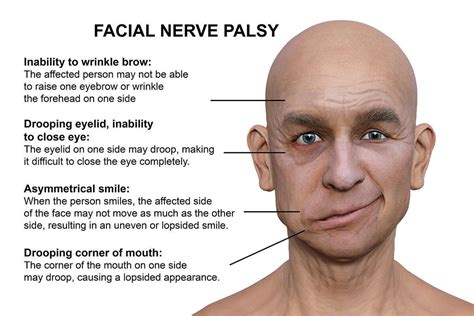
The causes of Bell palsy are not fully understood, but research suggests that it may be related to a variety of factors. One possible cause is a viral infection, such as herpes simplex or Lyme disease. These infections can cause inflammation and damage to the facial nerve, leading to the symptoms of Bell palsy. Another possible cause is an autoimmune disorder, such as multiple sclerosis or Guillain-Barre syndrome. These conditions can cause the immune system to attack the facial nerve, leading to inflammation and damage.
In some cases, Bell palsy may be caused by trauma to the face, such as a blow to the head or a surgical procedure. This can cause damage to the facial nerve, leading to the symptoms of Bell palsy. Other possible causes of Bell palsy include tumors, stroke, or diabetes. In some cases, the cause of Bell palsy may be unknown, and it is referred to as idiopathic Bell palsy.
Types of Bell Palsy
There are several types of Bell palsy, including:- Idiopathic Bell palsy: This is the most common type of Bell palsy, and it is characterized by inflammation of the facial nerve without any known cause.
- Herpes zoster Bell palsy: This type of Bell palsy is caused by the herpes zoster virus, which is the same virus that causes shingles.
- Lyme disease Bell palsy: This type of Bell palsy is caused by the bacteria that cause Lyme disease.
- Traumatic Bell palsy: This type of Bell palsy is caused by trauma to the face, such as a blow to the head or a surgical procedure.
What are the Symptoms of Bell Palsy
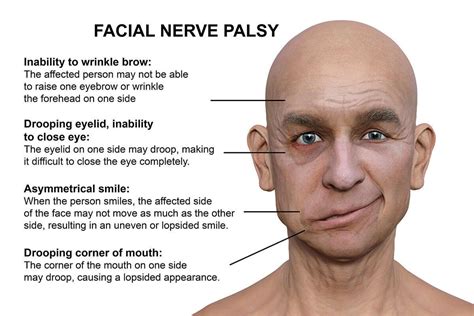
The symptoms of Bell palsy can vary from person to person, but they often include:
- Sudden weakness or paralysis of the facial muscles on one side of the face
- Drooping or numbness of the face
- Difficulty smiling, frowning, or showing facial expressions
- Difficulty closing the eye or blinking
- Pain or discomfort in the face
- Headache
- Difficulty tasting or hearing
The symptoms of Bell palsy typically develop quickly, often over the course of just a few hours or days. In some cases, the symptoms may be mild and may not require treatment. However, in other cases, the symptoms can be severe and may require prompt medical attention.
Treatment Options for Bell Palsy
The treatment for Bell palsy depends on the severity of the symptoms and the underlying cause of the condition. In some cases, treatment may not be necessary, and the symptoms may resolve on their own. However, in other cases, treatment may be necessary to relieve symptoms and prevent complications.Some common treatment options for Bell palsy include:
- Corticosteroids: These medications can help reduce inflammation and swelling in the facial nerve.
- Antiviral medications: These medications can help treat viral infections that may be causing the symptoms of Bell palsy.
- Pain relief medications: These medications can help relieve pain and discomfort in the face.
- Physical therapy: This can help improve facial muscle strength and coordination.
How is Bell Palsy Diagnosed
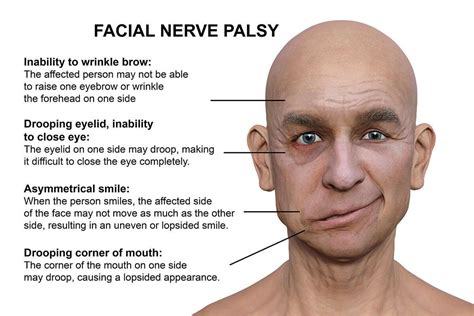
Bell palsy is often diagnosed based on the symptoms and a physical examination. A doctor may perform a series of tests, including a neurological examination, to rule out other possible causes of the symptoms. In some cases, additional tests such as an MRI or EMG may be ordered to confirm the diagnosis.
The diagnostic tests for Bell palsy may include:
- Neurological examination: This test can help evaluate the function of the facial nerve and the muscles of the face.
- Electromyography (EMG): This test can help evaluate the function of the facial muscles and the nerve that controls them.
- Magnetic resonance imaging (MRI): This test can help evaluate the facial nerve and the surrounding tissues for signs of inflammation or damage.
- Blood tests: These tests can help rule out other possible causes of the symptoms, such as infections or autoimmune disorders.
Complications of Bell Palsy
In some cases, Bell palsy can cause complications, such as:- Permanent facial weakness or paralysis
- Eye problems, such as dryness or irritation
- Hearing loss or tinnitus
- Taste disturbances
- Facial spasms or twitching
It is essential to seek medical attention if you experience any symptoms of Bell palsy, as prompt treatment can help relieve symptoms and prevent complications.
Prevention of Bell Palsy
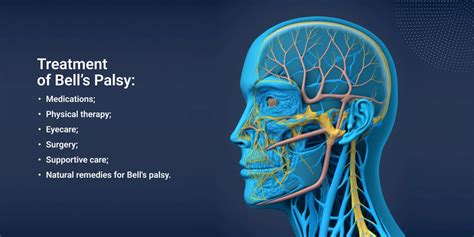
While there is no sure way to prevent Bell palsy, there are some steps you can take to reduce your risk of developing the condition. These include:
- Practicing good hygiene, such as washing your hands frequently and avoiding close contact with people who are sick
- Getting vaccinated against viral infections, such as herpes zoster and Lyme disease
- Avoiding trauma to the face, such as wearing a helmet when participating in sports or activities that may cause head injury
- Managing underlying medical conditions, such as diabetes and high blood pressure
By taking these steps, you can help reduce your risk of developing Bell palsy and promote overall health and well-being.
Lifestyle Changes for Bell Palsy
If you have been diagnosed with Bell palsy, there are some lifestyle changes you can make to help manage your symptoms and promote recovery. These include:- Getting plenty of rest and avoiding strenuous activities
- Applying warm or cold compresses to the affected area to help relieve pain and discomfort
- Practicing facial exercises to help improve muscle strength and coordination
- Avoiding rubbing or touching the affected area, as this can cause further irritation and inflammation
By making these lifestyle changes, you can help manage your symptoms and promote recovery from Bell palsy.
Treatment Options for Bell Palsy
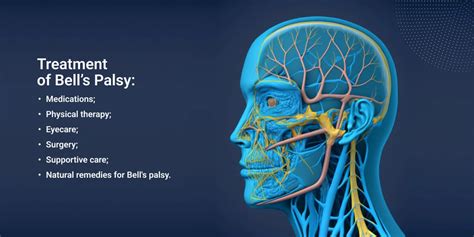
The treatment options for Bell palsy depend on the severity of the symptoms and the underlying cause of the condition. In some cases, treatment may not be necessary, and the symptoms may resolve on their own. However, in other cases, treatment may be necessary to relieve symptoms and prevent complications.
Some common treatment options for Bell palsy include:
- Corticosteroids: These medications can help reduce inflammation and swelling in the facial nerve.
- Antiviral medications: These medications can help treat viral infections that may be causing the symptoms of Bell palsy.
- Pain relief medications: These medications can help relieve pain and discomfort in the face.
- Physical therapy: This can help improve facial muscle strength and coordination.
In some cases, surgery may be necessary to relieve pressure on the facial nerve or to repair any damage to the nerve.
Surgical Options for Bell Palsy
Surgical options for Bell palsy may include:- Decompression surgery: This surgery can help relieve pressure on the facial nerve and promote recovery.
- Nerve repair surgery: This surgery can help repair any damage to the facial nerve and promote recovery.
- Facial reanimation surgery: This surgery can help restore facial function and promote recovery.
Surgery is typically reserved for severe cases of Bell palsy, and it is usually performed by a specialist, such as a neurosurgeon or a plastic surgeon.
Recovery from Bell Palsy
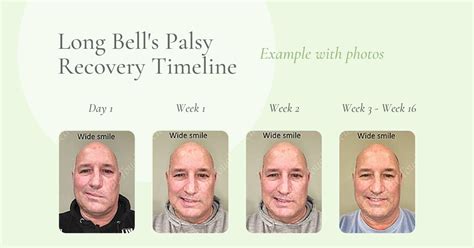
The recovery from Bell palsy can vary from person to person, depending on the severity of the symptoms and the underlying cause of the condition. In some cases, the symptoms may resolve on their own, without the need for treatment. However, in other cases, treatment may be necessary to relieve symptoms and promote recovery.
The recovery process for Bell palsy may include:
- Rest and relaxation: Getting plenty of rest and avoiding strenuous activities can help promote recovery.
- Physical therapy: This can help improve facial muscle strength and coordination.
- Medications: Corticosteroids, antiviral medications, and pain relief medications can help relieve symptoms and promote recovery.
- Surgery: In some cases, surgery may be necessary to relieve pressure on the facial nerve or to repair any damage to the nerve.
By following a treatment plan and making lifestyle changes, you can help promote recovery from Bell palsy and regain facial function.
Coping with Bell Palsy
Coping with Bell palsy can be challenging, both physically and emotionally. It is essential to seek support from family, friends, and healthcare professionals to help manage symptoms and promote recovery.Some coping strategies for Bell palsy include:
- Practicing stress-reducing techniques, such as meditation or deep breathing
- Getting plenty of rest and avoiding strenuous activities
- Applying warm or cold compresses to the affected area to help relieve pain and discomfort
- Practicing facial exercises to help improve muscle strength and coordination
By using these coping strategies, you can help manage symptoms and promote recovery from Bell palsy.
What is Bell palsy?
+Bell palsy is a condition that causes temporary weakness or paralysis of the muscles in one side of the face.
What are the symptoms of Bell palsy?
+The symptoms of Bell palsy can include sudden weakness or paralysis of the facial muscles on one side of the face, drooping or numbness of the face, difficulty smiling or showing facial expressions, and pain or discomfort in the face.
How is Bell palsy diagnosed?
+Bell palsy is often diagnosed based on the symptoms and a physical examination. Additional tests, such as an MRI or EMG, may be ordered to confirm the diagnosis.
What are the treatment options for Bell palsy?
+The treatment options for Bell palsy depend on the severity of the symptoms and the underlying cause of the condition. Treatment may include corticosteroids, antiviral medications, pain relief medications, physical therapy, and surgery.
Can Bell palsy be prevented?
+While there is no sure way to prevent Bell palsy, there are some steps you can take to reduce your risk of developing the condition, such as practicing good hygiene, getting vaccinated against viral infections, and avoiding trauma to the face.
If you have any questions or concerns about Bell palsy, do not hesitate to reach out to a healthcare professional. They can provide you with more information and help you develop a treatment plan to manage your symptoms and promote recovery. Additionally, you can share this article with others who may be experiencing similar symptoms, and encourage them to seek medical attention if they are experiencing any of the symptoms of Bell palsy. By working together, we can help raise awareness and promote understanding of this condition, and provide support to those who are affected by it.
